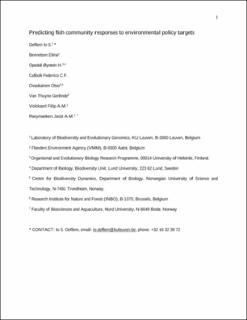| dc.contributor.author | Deflem, Io S. | |
| dc.contributor.author | Bennetsen, Elina | |
| dc.contributor.author | Opedal, Øystein H. | |
| dc.contributor.author | Calboli, Federico C. F. | |
| dc.contributor.author | Ovaskainen, Otso | |
| dc.contributor.author | Van Thuyne, Gerlinde | |
| dc.contributor.author | Volckaert, Filip A. M. | |
| dc.contributor.author | Raeymaekers, Joost A. M. | |
| dc.date.accessioned | 2022-09-07T07:29:47Z | |
| dc.date.available | 2022-09-07T07:29:47Z | |
| dc.date.created | 2021-12-01T11:14:05Z | |
| dc.date.issued | 2021 | |
| dc.identifier.citation | Biodiversity and Conservation. 2021, 30 (5), 1457-1478. | en_US |
| dc.identifier.issn | 0960-3115 | |
| dc.identifier.uri | https://hdl.handle.net/11250/3016164 | |
| dc.description.abstract | The European Union adopted the Water Framework Directive (WFD) in the year 2000 to tackle the rapid degradation of freshwater systems. However, biological, hydromorphological, and physico-chemical water quality targets are currently not met, and identifying successful policy implementation and management actions is of key importance. We built a joint species distribution model for riverine fish in Flanders (Belgium) to better understand the response of fish communities to current environmental policy goals. Environmental covariates included physico-chemical variables and hydromorphological quality indices, while waterway distances accounted for spatial effects. We detected strong effects of physico-chemistry on fish species’ distributions. Evaluation of fish community responses to simulated policy scenarios revealed that targeting a ‘good’ status, following the WFD, increases average species richness with a fraction of species (0.13–0.69 change in accumulated occurrence probabilities). Targeting a ‘very good’ status, however, predicted an increase of 0.17–1.38 in average species richness. These simulations indicated that riverbed quality, nitrogen, and conductivity levels should be the focal point of policy. However, the weak response of species to a ‘good’ quality together with the complexity of nutrient-associated problems, suggest a challenging future for river restoration in Flanders. | en_US |
| dc.language.iso | eng | en_US |
| dc.publisher | Springer | en_US |
| dc.title | Predicting fish community responses to environmental policy targets | en_US |
| dc.type | Journal article | en_US |
| dc.description.version | submittedVersion | en_US |
| dc.source.pagenumber | 1457-1478 | en_US |
| dc.source.volume | 30 | en_US |
| dc.source.journal | Biodiversity and Conservation | en_US |
| dc.source.issue | 5 | en_US |
| dc.identifier.doi | 10.1007/s10531-021-02154-2 | |
| dc.identifier.cristin | 1962517 | |
| dc.relation.project | Andre: Academy of Finland | en_US |
| dc.relation.project | Andre: Research Foundation—Flanders | en_US |
| cristin.ispublished | true | |
| cristin.fulltext | preprint | |
| cristin.qualitycode | 1 | |
